engine Lancia Delta 2012 Owner handbook (in English)
[x] Cancel search | Manufacturer: LANCIA, Model Year: 2012, Model line: Delta, Model: Lancia Delta 2012Pages: 295, PDF Size: 8.29 MB
Page 204 of 295

202IN AN EMERGENCY
TAKING OUT THE SPACE-SAVER WHEEL
Please note that:
❍the jack weight is 1.76 kg;
❍the jack requires no adjustment;
❍the jack cannot be repaired; if it breaks, it must be re-
placed with a new one of the same type;
❍no tool other than its cranking device may be fitted on
the jack.
To change a wheel proceed as follows:
❍stop the car where it is not a danger to other road
users and you can replace the wheel safely. The
ground must be flat and sufficiently compact;
❍turn the engine off and engage the handbrake;
❍engage first gear or reverse;
❍lift up the luggage compartment mat using handle A-
fig. 10 (in the presence of a double load platform, first
lift the upper cover and then the luggage compart-
ment mat);
❍unscrew the locking device B-fig. 10;
❍take out the tool box C and place it next to the wheel
to be changed;
❍remove the space saver wheel D-fig. 10;
❍use the provided screwdriver to remove the hub cap,
levering the dedicated opening on the outer edge;
fig. 10L0E0081m
Page 221 of 295
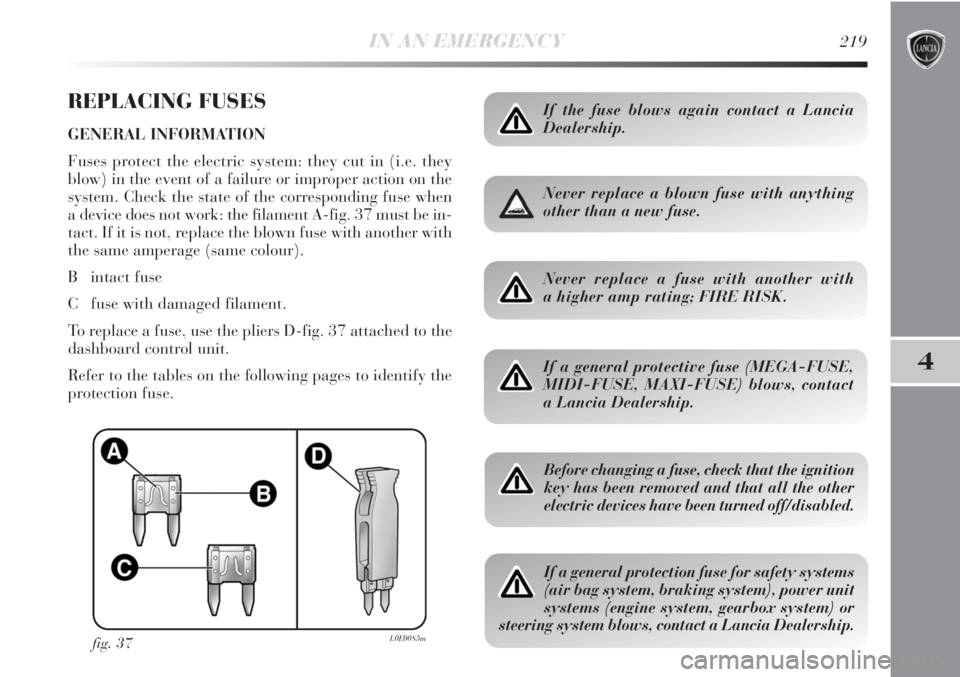
IN AN EMERGENCY219
4
REPLACING FUSES
GENERAL INFORMATION
Fuses protect the electric system: they cut in (i.e. they
blow) in the event of a failure or improper action on the
system. Check the state of the corresponding fuse when
a device does not work: the filament A-fig. 37 must be in-
tact. If it is not, replace the blown fuse with another with
the same amperage (same colour).
B intact fuse
C fuse with damaged filament.
To replace a fuse, use the pliers D-fig. 37 attached to the
dashboard control unit.
Refer to the tables on the following pages to identify the
protection fuse.
fig. 37L0E0085m
If the fuse blows again contact a Lancia
Dealership.
Never replace a blown fuse with anything
other than a new fuse.
Never replace a fuse with another with
a higher amp rating; FIRE RISK.
If a general protective fuse (MEGA-FUSE,
MIDI-FUSE, MAXI-FUSE) blows, contact
a Lancia Dealership.
Before changing a fuse, check that the ignition
key has been removed and that all the other
electric devices have been turned off/disabled.
If a general protection fuse for safety systems
(air bag system, braking system), power unit
systems (engine system, gearbox system) or
steering system blows, contact a Lancia Dealership.
Page 223 of 295

IN AN EMERGENCY221
4
Engine compartment fuse box fig. 39 and 40
A second fuse box is located on the right side of the en-
gine compartment, next to the battery. To access this fuse
box release the side tabs and remove cover L. The ID
number of the electrical component corresponding to
each fuse can be found on the back of the cover.
fig. 39L0E0088mfig. 38aL0E0211m
If you need to wash the engine compartment,
take care not to directly hit the engine com-
partment fuse box with the jet of water.
Additional fuses (1.4 Turbo Multi Air versions)
On the 1.4 Turbo Multi Air versions there are four addi-
tional fuses (fig. 38a) next to the dashboard junction unit.
Page 225 of 295

IN AN EMERGENCY223
4
FUSE SUMMARY TABLE
F12
F12
F13
F13
F31
F33
F34
F35
F36
F37
F38
F39
F40
F417.5
15
7.5
15
5
20
20
5
20
7.5
10
10
30
7.538
38
38
38
38
38
38
38
38
38
38
38
38
38
USERS FUSE AMPS FIGURE
Right dipped beam headlight
Right dipped beam headlight (Xenon gas discharge bulb)
Left dipped beam headlight, headlight alignment corrector
Left dipped beam headlight (Xenon gas discharge bulb)
Climate control system fan relay coil, body computer
Left rear window winder
Right rear window winder
Reversing lights, engine compartment junction unit relay coils,
brake light pedal control (normally closed contact),
water in diesel sensor, air flow meter/control on clutch pedal
and brake servo pressure sensor (1.4 Turbo Multi Air versions)
Central locking system control unit, fuel flap,
dead lock, tailgate release
Third brake light, instrument panel, Adaptive Headlights Node
(1.4 Turbo Multi Air versions excluded), control unit on left hand
gas discharge headlight (1.4 Turbo Multi Air versions excluded)
Front roof lights, rear central roof light, driver side and passenger side sun
visor lights, luggage compartment roof light, glove compartment courtesy
light (Platinum trim level with optional sun roof - excluding MultiAir version)
Radio wiring/Radio/Radio Navigator (excluding MultiAir versions),
Blue&Me
TMNode, alarm siren, alarm system on roof light, climate control
unit, tyre pressure monitoring system control unit, diagnosis socket connector,
rear roof lights, voltage stabiliser (MultiAir versions without optional HI-FI)
Heated rear window
Electric door mirror demisters, demisters on windscreen jets
Page 230 of 295

228IN AN EMERGENCY
When towing, remember that without the
help of the brake servo and electric power
steering, a greater effort is required on the
pedal and steering wheel. Do not use flexible ca-
bles when towing and avoid jerky movements.
While towing, make sure not to damage parts in
contact with the car. When towing the vehicle, it is
compulsory to respect specific highway code reg-
ulations relating to the tow hook and procedures for
towing on the road. Do not start the engine while
towing the car. Before tightening the ring clean the
threaded housing thoroughly. Make sure that the
ring is securely fastened before towing the car.
The front and rear tow hooks must only be
used for emergency situations on the road.
The car may be towed for short distances
when a dedicated device is used in compliance with
the Highway Code (rigid bar), and in order to move
the vehicle on the road in preparation for towing by
a tow truck. Tow hooks MUST NOT be used to tow
vehicles off the road or where there are obstacles
and/or for towing operations using cables or other
non-rigid devices. Respecting the above conditions,
towing must take place with two vehicles (one tow-
ing, the other towed) aligned as much as possible
along the same centre line.
fig. 45L0E0091m
Before towing, turn the ignition key to MAR
and then to STOP without removing it. The
steering column will automatically lock
when the key is removed and the wheels cannot be
steered.
Page 233 of 295
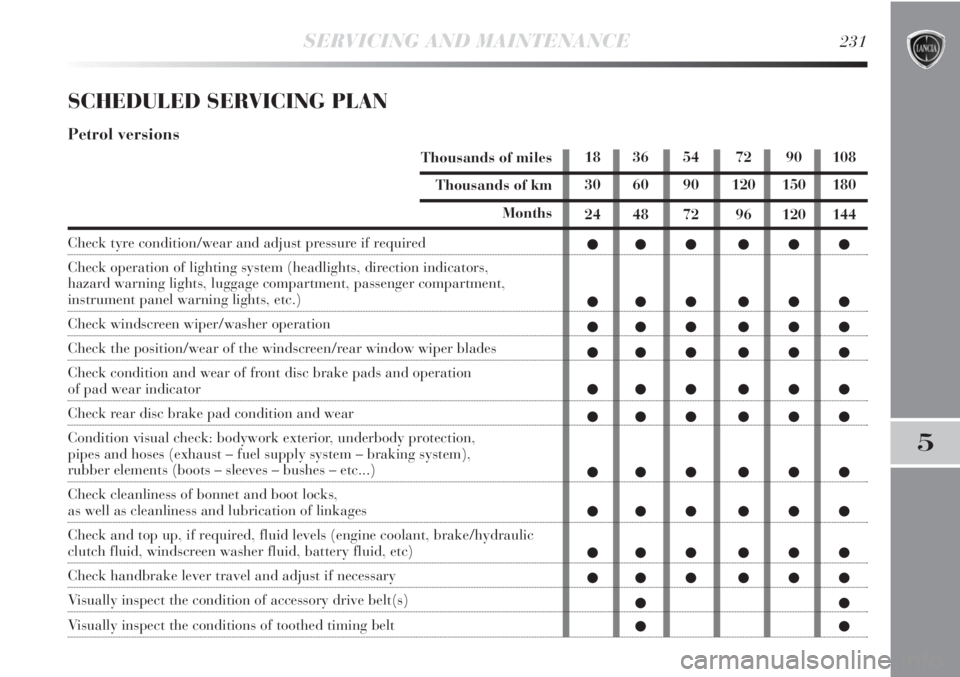
18 36 54 72 90 108
30 60 90 120 150 180
24 48 72 96 120 144
●●● ●●●
●●● ●●●
●●● ●●●
●●● ●●●
●●● ●●●
●●● ●●●
●●● ●●●
●●● ●●●
●●● ●●●
●●● ●●●
●●
●●
SERVICING AND MAINTENANCE231
5
SCHEDULED SERVICING PLAN
Petrol versions
Thousands of miles
Thousands of km
Months
Check tyre condition/wear and adjust pressure if required
Check operation of lighting system (headlights, direction indicators,
hazard warning lights, luggage compartment, passenger compartment,
instrument panel warning lights, etc.)
Check windscreen wiper/washer operation
Check the position/wear of the windscreen/rear window wiper blades
Check condition and wear of front disc brake pads and operation
of pad wear indicator
Check rear disc brake pad condition and wear
Condition visual check: bodywork exterior, underbody protection,
pipes and hoses (exhaust – fuel supply system – braking system),
rubber elements (boots – sleeves – bushes – etc...)
Check cleanliness of bonnet and boot locks,
as well as cleanliness and lubrication of linkages
Check and top up, if required, fluid levels (engine coolant, brake/hydraulic
clutch fluid, windscreen washer fluid, battery fluid, etc)
Check handbrake lever travel and adjust if necessary
Visually inspect the condition of accessory drive belt(s)
Visually inspect the conditions of toothed timing belt
Page 234 of 295
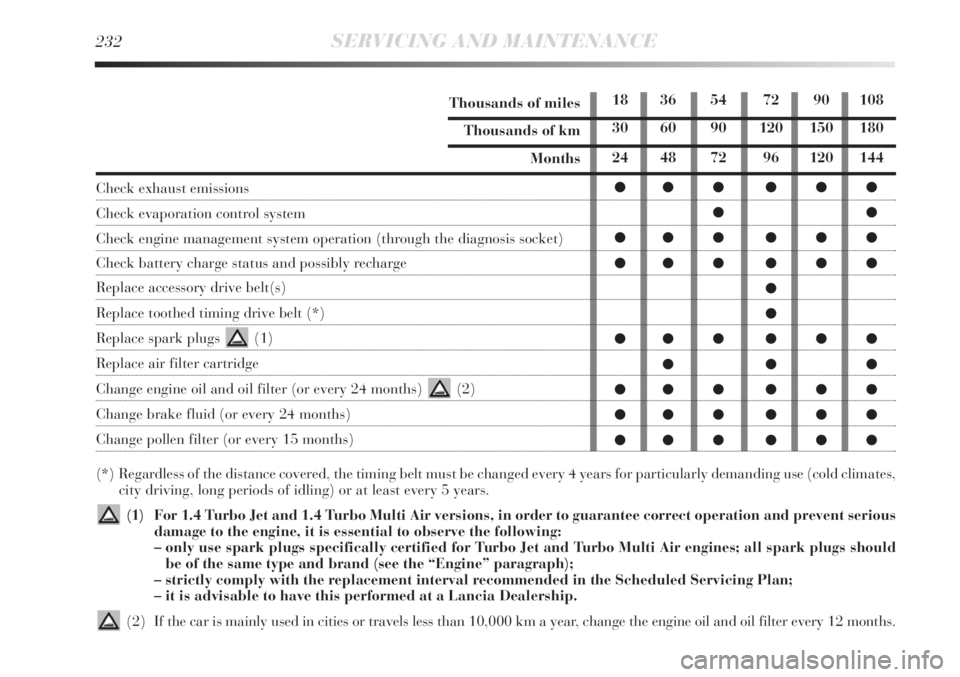
232SERVICING AND MAINTENANCE
Thousands of miles
Thousands of km
Months
Check exhaust emissions
Check evaporation control system
Check engine management system operation (through the diagnosis socket)
Check battery charge status and possibly recharge
Replace accessory drive belt(s)
Replace toothed timing drive belt (*)
Replace spark plugs (1)
Replace air filter cartridge
Change engine oil and oil filter (or every 24 months) (2)
Change brake fluid (or every 24 months)
Change pollen filter (or every 15 months)
(*) Regardless of the distance covered, the timing belt must be changed every 4 years for particularly demanding use (cold climates,
city driving, long periods of idling) or at least every 5 years.
(1) For 1.4 Turbo Jet and 1.4 Turbo Multi Air versions, in order to guarantee correct operation and prevent serious
damage to the engine, it is essential to observe the following:
– only use spark plugs specifically certified for Turbo Jet and Turbo Multi Air engines; all spark plugs should
be of the same type and brand (see the “Engine” paragraph);
– strictly comply with the replacement interval recommended in the Scheduled Servicing Plan;
– it is advisable to have this performed at a Lancia Dealership.
(2) If the car is mainly used in cities or travels less than 10,000 km a year, change the engine oil and oil filter every 12 months.
18 36 54 72 90 108
30 60 90 120 150 180
24 48 72 96 120 144
●●● ●●●
●●
●●● ●●●
●●● ●●●
●
●
●●● ●●●
●●●
●●● ●●●
●●● ●●●
●●● ●●●
Page 235 of 295
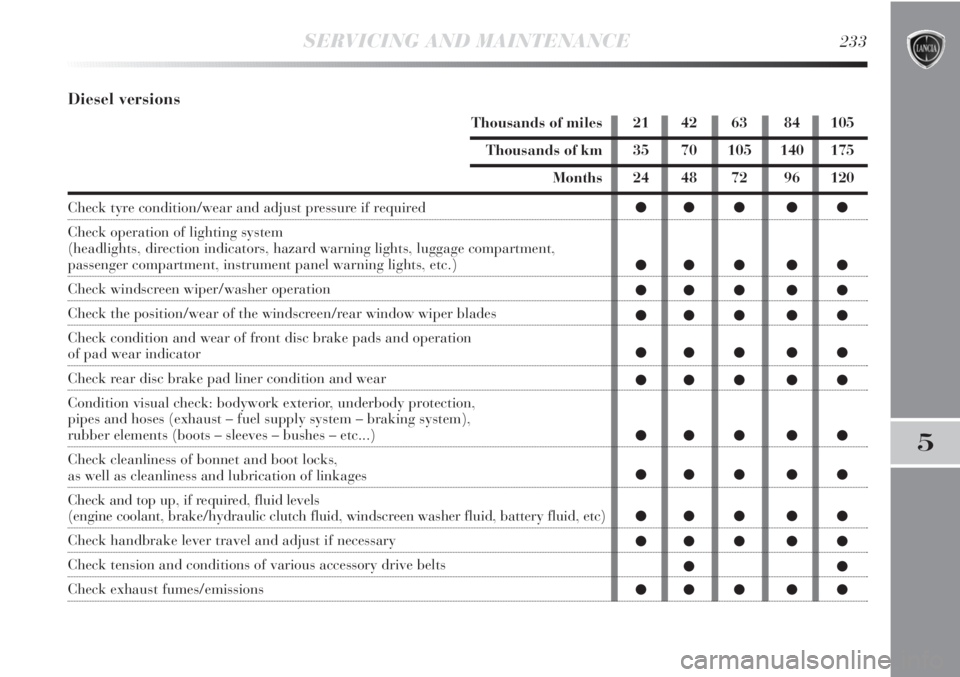
SERVICING AND MAINTENANCE233
5
21 42 63 84 105
35 70 105 140 175
24 48 72 96 120
●● ● ● ●
●● ● ● ●
●● ● ● ●
●● ● ● ●
●● ● ● ●
●● ● ● ●
●● ● ● ●
●● ● ● ●
●● ● ● ●
●● ● ● ●
●●
●● ● ● ●
Diesel versions
Thousands of miles
Thousands of km
Months
Check tyre condition/wear and adjust pressure if required
Check operation of lighting system
(headlights, direction indicators, hazard warning lights, luggage compartment,
passenger compartment, instrument panel warning lights, etc.)
Check windscreen wiper/washer operation
Check the position/wear of the windscreen/rear window wiper blades
Check condition and wear of front disc brake pads and operation
of pad wear indicator
Check rear disc brake pad liner condition and wear
Condition visual check: bodywork exterior, underbody protection,
pipes and hoses (exhaust – fuel supply system – braking system),
rubber elements (boots – sleeves – bushes – etc...)
Check cleanliness of bonnet and boot locks,
as well as cleanliness and lubrication of linkages
Check and top up, if required, fluid levels
(engine coolant, brake/hydraulic clutch fluid, windscreen washer fluid, battery fluid, etc)
Check handbrake lever travel and adjust if necessary
Check tension and conditions of various accessory drive belts
Check exhaust fumes/emissions
Page 236 of 295
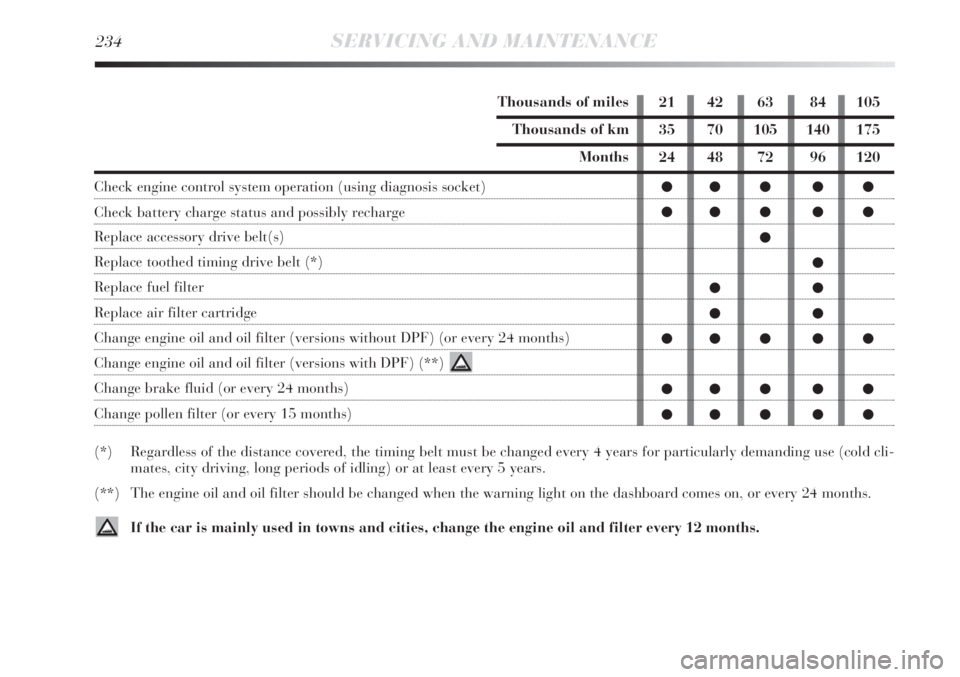
234SERVICING AND MAINTENANCE
Thousands of miles
Thousands of km
Months
Check engine control system operation (using diagnosis socket)
Check battery charge status and possibly recharge
Replace accessory drive belt(s)
Replace toothed timing drive belt (*)
Replace fuel filter
Replace air filter cartridge
Change engine oil and oil filter (versions without DPF) (or every 24 months)
Change engine oil and oil filter (versions with DPF) (**)
Change brake fluid (or every 24 months)
Change pollen filter (or every 15 months)
(*) Regardless of the distance covered, the timing belt must be changed every 4 years for particularly demanding use (cold cli-
mates, city driving, long periods of idling) or at least every 5 years.
(**) The engine oil and oil filter should be changed when the warning light on the dashboard comes on, or every 24 months.
If the car is mainly used in towns and cities, change the engine oil and filter every 12 months.
21 42 63 84 105
35 70 105 140 175
24 48 72 96 120
●● ● ● ●
●● ● ● ●
●
●
●●
●●
●● ● ● ●
●● ● ● ●
●● ● ● ●
Page 237 of 295
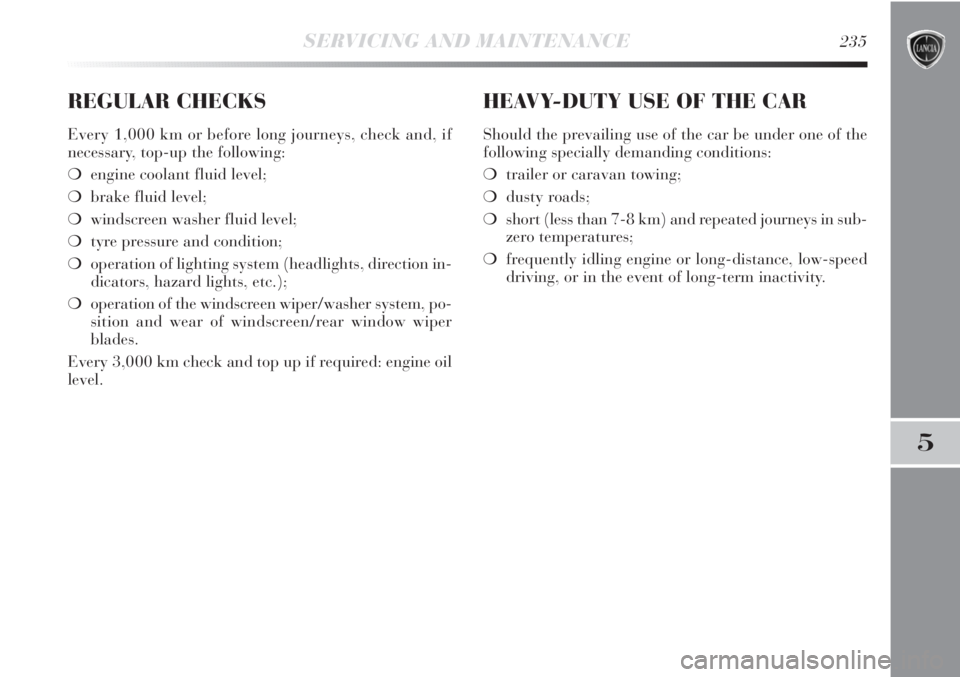
SERVICING AND MAINTENANCE235
5
REGULAR CHECKS
Every 1,000 km or before long journeys, check and, if
necessary, top-up the following:
❍engine coolant fluid level;
❍brake fluid level;
❍windscreen washer fluid level;
❍tyre pressure and condition;
❍operation of lighting system (headlights, direction in-
dicators, hazard lights, etc.);
❍operation of the windscreen wiper/washer system, po-
sition and wear of windscreen/rear window wiper
blades.
Every 3,000 km check and top up if required: engine oil
level.
HEAVY-DUTY USE OF THE CAR
Should the prevailing use of the car be under one of the
following specially demanding conditions:
❍trailer or caravan towing;
❍dusty roads;
❍short (less than 7-8 km) and repeated journeys in sub-
zero temperatures;
❍frequently idling engine or long-distance, low-speed
driving, or in the event of long-term inactivity.